Architecture
It is commonly accepted that the wireless spectrum is the scarce resource in wireless communications. However, more than 95% of the usage is below 3 GHz. The static assignment of the spectrum results in inefficient usage of the spectrum. The utilization of the spectrum can be as low as 10% [1]. Dynamic access to the spectrum can be considered as a method for solving spectrum scarcity. The Federal Communications Commission (FCC) in the U.S.A. is reviewing its policies regarding the use of licensed bands by unlicensed users [2]. (The use of the spectrum in Turkey is regulated by Bilgi Teknolojileri ve İletişim Kurumu (BTK). Information about the spectrum use in Turkey may be retrieved at (https://ifis.btk.gov.tr/wmfys/millifrekanssorgu.aspx).
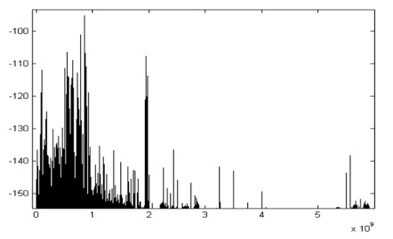
Figure 1. Measurement of 0-6 GHz spectrum utilization at Berkeley Wireless Research Center [3]
Cognitive Radio (CR) is a paradigm for wireless communication in which either a network or a wireless node changes its transmission or reception parameters to communicate efficiently avoiding interference with licensed or unlicensed users. This alteration of parameters is based on the active monitoring of several factors in the external and internal radio environment, such as radio frequency spectrum, user behavior, and network state. The idea of CR was first proposed by Joseph Mitola III and Gerald Q. Maguire, Jr in [4]. It was thought of as an ideal goal towards which a Software-Defined Radio (SDR) platform should evolve: a fully reconfigurable wireless black-box that automatically changes its communication variables in response to network and user demands.
Definitions
Mitola's definition: A radio driven by a large store of a priori knowledge, searching out by reasoning ways to deliver the services the user wants [4].
Haykin's definition: Radios that improve spectral efficiency by sensing the environment and then filling the discovered gaps of unused licensed spectrum with their own transmissions [5].
Consciousness: This term refers to awareness of one's own existence, sensations, thoughts, surroundings, etc., including emotions and free will.
Cognitiveness: This term refers to mental processes of perception (sensing), memory, judgment, and reasoning.
This project is focused on Cognitive Radio Networks (CRN). My research addresses the following issues in CRN:
- CR Physical Platform
- CRN Architecture
- Spectrum Sensing/ Management/ Mobility/ Sharing
- Routing Layer Issues
- Software Defined Radio
- Software Defined Radio As a Base of Cognitive Radio
CR Physical Platform
Cognitive radio [4] is considered as the key enabling technology for Next Generation Wireless Systems (NGWS) and dynamic spectrum access systems. Cognitive Radio Mobile Terminal (CogMT) is defined as an intelligent wireless communication device that works on Software Defined Radio (SDR) physical platform [6]. It has the capabilities of knowing and understanding the spectral environment it is operating in, adapting its physical radio parameters to the changing spectral conditions and learning from its radio environment [5]. An SDR system is a radio communication system that can potentially tune to different frequency bands and receive any modulation across a large frequency spectrum by means of as little hardware as possible, processing the digitized signals in software. In the context of NGWS, cognitive radio enables mobile users to dynamically access and to fairly share the spectrum with other users while benefiting from the advantages of available subsystems in NGWS. In the literature the cognitive radio users are called Secondary Users (SUs) and the licensed users are called Primary Users (PUs) of those bands [7]. SUs access the spectrum dynamically for underutilized bands without causing harm to PUs, as a result, spectrum utilization increases. The cognitive radio is, therefore, an accelerating trend of the current wireless technology research.
The ideal receiver scheme would be to attach an analog to digital converter to an antenna. A digital signal processor would read the converter, and then its software would transform the stream of data from the converter to any other form the application requires. An ideal transmitter would be similar. A digital signal processor would generate a stream of numbers. These would be sent to a digital to analog converter connected to a radio antenna. The ideal scheme is, due to the actual technology progress limits, not completely realizable, however. The actual practical solution is to let the software processing stage be preceded by a front-end that preconditions the input signals to give them characteristics that enable the subsequent stage to elaborate them. Current (2007-2008) digital electronics are not sufficient to receive directly typical radio signals over approximately 40MHz. An ideal software radio has to collect and process samples at more than twice the maximum frequency at which it is to operate. Actual software radios, for frequencies below 40MHz, use a direct-conversion hardware solution. In this solution an analog-to-digital converter (ADC) is connected almost directly to the antenna (some preamplifier and impedance adapting circuitry is present to ensure that the input of the ADC is correctly matched to the antenna). The output stream of digital data obtained from the ADC is then passed to the software defined processing stages.
Our focus on this subject is the software architecture design of handheld devices that works on SDR physical platform. CogMT device design also includes the artificial intelligence capabilities. Regardless of operating frequency range, a wideband front-end for a cognitive radio could have an architecture as depicted in Figure 2. The wideband RF signal presented at the antenna of a cognitive radio includes signals from close and widely separated transmitters and from transmitters operating at widely different power levels and channel bandwidths. As a result, detection of weak signals must frequently be performed in the presence of very strong signals. Thus, there will be extremely stringent requirements placed on the linearity of the RF analog circuits as well as their ability to operate over wide bandwidths. In order to keep the requirements on the final analog to digital (A/D) converter at a reasonable level in a mostly digital architecture, front-end design needs a tunable notch analog processing block that would provide a dynamic range control.
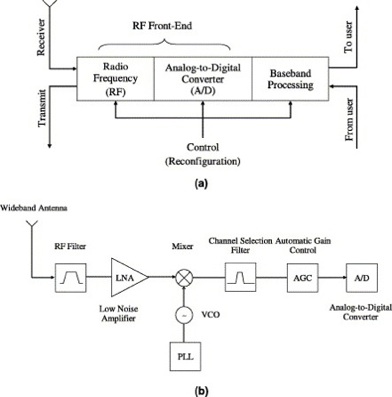
Figure 2. Physical architecture of CR: (a) CR transceiver and (b) wideband RF/analog front-end architecture [7]
RF hardware for the cognitive radio should be capable of tuning to any part of a large range of frequency spectrum. Also such spectrum sensing enables real-time measurements of spectrum information from radio environment. Generally, a wideband front-end architecture for the cognitive radio has the following structure as shown in Figure 2(b). The components of a cognitive radio RF front-end are presented in [7]:
RF filter: The RF filter selects the desired band by bandpass filtering the received RF signal.
Low noise amplifier (LNA): The LNA amplifies the desired signal while simultaneously minimizing noise component.
Mixer: In the mixer, the received signal is mixed with locally generated RF frequency and converted to the baseband or the intermediate frequency (IF).
Voltage-controlled oscillator (VCO): The VCO generates a signal at a specific frequency for a given voltage to mix with the incoming signal. This procedure converts the incoming signal to baseband or an intermediate frequency.
Phase locked loop (PLL): The PLL ensures that a signal is locked on a specific frequency and can also be used to generate precise frequencies with fine resolution.
Channel selection filter: The channel selection filter is used to select the desired channel and to reject the adjacent channels. There are two types of channel selection filters. The direct conversion receiver uses a low-pass filter for the channel selection. On the other hand, the superheterodyne receiver adopts a bandpass filter.
Automatic gain control (AGC): The AGC maintains the gain or output power level of an amplifier constant over a wide range of input signal levels.
In this architecture, a wideband signal is received through the RF front-end, sampled by the high speed analog-to-digital (A/D) converter, and measurements are performed for the detection of the licensed user signal. However, there exist some limitations on developing the cognitive radio front-end. The wideband RF antenna receives signals from various transmitters operating at different power levels, bandwidths, and locations. As a result, the RF front-end should have the capability to detect a weak signal in a large dynamic range.
CRN Architecture
According to FCC, several parts of the fixed spectrum are under-utilized while some spectrum bands are heavily used and subject to high interference [8]. Temporarily unused spectrum bands (a.k.a. spectrum holes or white spaces) can be used by opportunistic radios to improve the overall spectrum utilization. Hence, new spectrum allocation methods and technologies are necessary to maximize the benefits of the limited spectrum resource by learning the unused spectrum bands in given time and location. Dynamic Spectrum Access (DSA) technique aims to solve spectrum allocation problems. The overall system that learns the operating environment and adapts its operating parameters according to its surrounding and uses DSA technique for efficient spectrum usage is called Cognitive Radio Network (CRN). In Figure 3, spectrum holes are employed by CRN in an example scenario. In different areas the usage of the spectrum differs, so spectrum hole locations and their durations vary. CRN uses these spectrum holes for providing service to its users without causing harm to other users. Therefore, the change of parameters are observed by active monitoring of several factors in the external and internal radio environment, such as radio frequency spectrum, user behavior and network state.
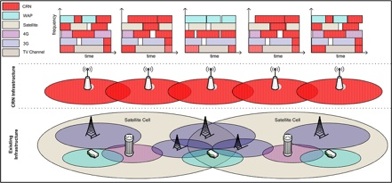
Figure 3. CRN frequency usage example
In the architectural foundation, we define some network agents to manage and support DSA nature of cognitive networks. The following terms are necessary for our proposed architecture:
Frequency Holder (FH): FH represents the institution that has the right of using a spectrum band in a particular region by a long term leasing agreement with the governmental agencies.
Spectrum Broker (SB): SB is a network agent that interconnects wireless spectrum holder and the CR users.
Cognitive Radio Service Provider (CRSP): CRSP is an entity that provides cognitive radio services.
Cognitive Radio Service Provider Network (CRSPN): CRSPN is a cellular network which covers a broad geographical area and provides communication service for cognitive radios. A CRSPN can be owned by a CRSP or may be shared between some CRSPs. Moreover, establishment of these networks by some third party institutions is also possible. These institutions provide leasing of their networks by CRSPs.
Cognitive Radio Mobile Terminal (CogMT): Defined as an intelligent wireless communication device that works on Software Defined Radio (SDR) physical platform [6].
Cognitive Base Station (CogBS): CogBS works as a connection point that ties CogMTs to CRSPN and responsible for handling traffic and signaling between a CogMT and the CRN.
Advantages of establishing CRSPN:
- CRSPN forms a cellular network architecture which helps to organize cellular frequency reuse pattern.
- CRSPN architecture provides a new adaptive communication protocol rather than connecting various systems.
- Support for infrastructure aided security and authentication mechanisms.
- Allows making use of frequency bands allocated for broadcast communication.
- CRSPN architecture supports network agents to advertise frequencies to cognitive radios.
- Handoff is easier and manageable.
- Handoff latency is shorter.
Disadvantages of establishing CRSPN:
- Establishing CRSPN agents cause additional deployment costs.
- High power necessity due to long distance communication.
- High interference due to long distance communication.
We propose a network architecture for CRN that establishes CRSPN [p1]. Nodes in CRN has capabilities of transmitting and receiving at different frequency bands. CogMTs use frequencies as long as they don’t cause harm to primary users of the frequencies. Broker systems are introduced in the network architecture for learning and leasing the frequency holes in the channel. Entities and the interconnections of them are summarized in the Figure 4.
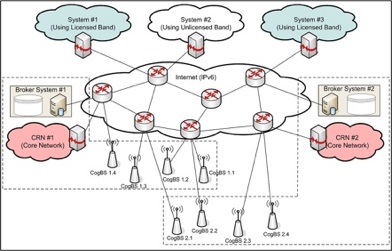
Figure 4. Architecture of CRN
We focus on architectural design of CRN and define the messages within interactions between entities. Our current research on this subject is presented on [p2] with flow charts of the interactions and the architectural design of the CRN.
Software Defined Radio
A Software Defined Radio (SDR) is a radio communication system which can tune to any frequency band and receive any modulation across a large frequency spectrum by using the same hardware as possible and process the signals through software. From mobile communication perspective it means user access to multiple systems from a single terminal. The logic behind a software radio is based on replacing the radio hardware components (Analog to digital converters, digital to analog converters, modulators, filters…) with the equivalent piece of software. In order to handle performance issues related to fast signal processing, FPGA (Field Programmable Gate Array) and DSP (Digital Signal Processor) based processing hardware is used instead of GPP (General Purpose Processor).
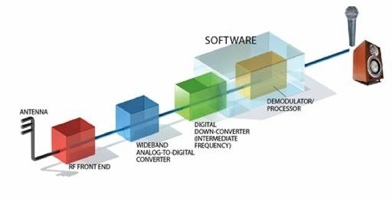
Figure 5. SDR infrastructure
The opportunities that the SDR offer makes it a candidate platform to solve the problems related to dynamic spectrum management. Capabilities of an SDR allow the handset to operate in heterogeneous wireless networks. In other words, an ideal SDR handset can dynamically change its running software and can tune to required frequency and modulation type at runtime.
Software Defined Radio As a Base of Cognitive Radio
Here are the definitions of both Cognitive Radio and SDR.
- Cognitive Radio is a radio device
- which can change its transmission or reception parameters
- to communicate efficiently
- avoiding interference with licensed or unlicensed users
- by active monitoring
- of external and internal radio environment
- radio frequency spectrum
- user behaviour
- network state
- or any other parameter
- SDR is a fully reconfigurable wireless black-box
- that automatically changes its communication variables
- in response to network and user demands.
When we map these two definitions to each other, it is noticed that SDR can satisfy the required flexibility that Cognitive Radio needs.
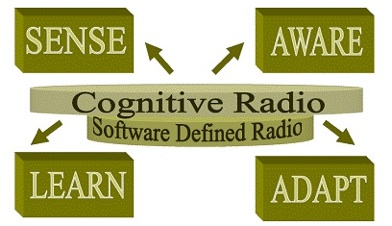
Figure 6. Relationship of SDR and Cognitive Radio
Our publications related with this project
[p1] D. Isler, H. B. Yilmaz, A. Zumbul, and T. Tugcu, "Akıllı Radyo Ağları İçin Bütünsel Bir Mimari," (in Turkish) IEEE 16. Sinyal Işleme, İletişim ve Uygulamaları Kurultayı 2008 (SIU’08), Didim, Turkey, 2008.
[p2] A. Zumbul and T. Tugcu, “Applying Design Patterns to SCA Implementations,” SDR Technical Conference and Product Exposition, Washington D.C, 2008.
[p3] D. Cavdar, H. B. Yilmaz, T. Tugcu, and F. Alagoz, "Resource Planning in Cognitive Radio Networks," IEEE International Symposium on Wireless Communication Systems (ISWCS), Siena, Italy, 2009.
[p4] H. B. Yilmaz, T. Tugcu, and F. Alagoz, "Uniform Quantizer for Cooperative Sensing in Cognitive Radio Networks," 21st IEEE International Symposium on Personal, Indoor and Mobile Radio Communications (PIMRC), Istanbul, Turkey, September 2010.
[p5] D. Cavdar, H. B. Yilmaz, T. Tugcu, and F. Alagoz "Analytical Modeling and Performance Evaluation of Cognitive Radio Networks," The Sixth Advanced International Conference on Telecommunications (AICT) 2010. (Best Paper Award)
[p6] M. I. Ulutas, M. S. Kuran, T. Tugcu “Hybrid Frame Structure for Improving Network Throughput in WiMAX Mesh Networks” Fifth International Conference on Broadband and Biomedical Communications, 2010 IB2COM, Malaga, Spain, December 2010.
[p7] M. Ozyurt, S. Ulug, and T. Tugcu, “Utilizing WiMAX Mesh Mode for Efficient IPTV Transmission," The 13th ACM International Conference on Modeling, Analysis and Simulation of Wireless and Mobile Systems (MSWiM 2010), Turkey, October 2010.
[p8] M. S. Kuran, G. Gur, T. Tugcu, and F. Alagoz, "Applications of Cross-Layer Paradigm for Improving the Performance of WiMAX," IEEE Wireless Communications Magazine, vol. 17, no. 3, pp. 86-95, June 2010.
[p9] D. Cavdar, H. B. Yilmaz, Tuna Tugcu, and F. Alagoz, "Analytical Modeling and Resource Planning for Cognitive Radio Systems," accepted to Wiley Journal on Wireless Communications and Mobile Computing Journal, 2010.
[p10] M. S. Kuran and T. Tugcu, “A Survey on Emerging Broadband Wireless Access Technologies,” Computer Networks, Vol. 51, No:11, pp 3013-3046, August 2007.
References
[1] N. Devroye, P. Mitran, et al., "Limits on communications in a cognitive radio channel," IEEE Communications Magazine, Vol.44, No.6, pp. 44-49, 2006.
[2] FCC, “Spectrum policy task force report,” ET Docket No.02-155, Nov 2002.
[3] D. Cabric, S. M. Mishra, et al., "Implementation issues in spectrum sensing for cognitive radios," 38th Asilomar Conference on Signals, Systems and Computers, 2004.
[4] J. Mitola III and G. Q. Maguire, Jr., "Cognitive radio: making software radios more personal," IEEE Wireless Communications, Vol. 6, No. 4, pp. 13-18, 1999.
[5] S. Haykin, "Cognitive radio: brain-empowered wireless communications," IEEE Journal on Selected Areas in Communications, Vol. 23, No. 2, pp. 201-220, 2005.
[6] K. J. Friedrich, "Software-defined radio: basics and evolution to cognitive radio," EURASIP Journal on Wireless Communication Networks, Vol. 5, No. 3, pp. 275-283, 2005.
[7] I. F. Akyildiz, W.-Y. Lee, et al., "NeXt generation/dynamic spectrum access/cognitive radio wireless networks: A survey," Computer Networks, Vol. 50, No. 13, pp. 2127-2159, 2006.
[8] P. Kolodzyetal, “Spectrum Policy Task Force Report,” Technical report, 2002.














